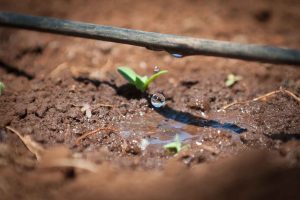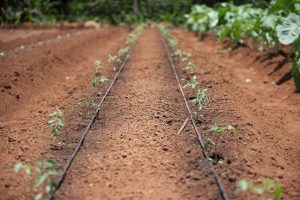Elad Levi of the Israeli drip irrigation-champion Netafim maps out a strategy to combat – and overcome – the two scourges hunger and poverty, especially in Africa. Simple financial schemes as well as investments in infrastructure and education will help bring about macro changes and assist farmers in improving their livelihoods, empower women and make young people stay in their homeland…

©Moshik Brin
It does not make for sensational headlines but one global problem has been with us for ages and it impacts millions. Now, its solution is within our reach. We’re talking about poverty and hunger in Africa.
A look at the facts: Some 75 percent of the world’s poorest countries are located in Africa, with nearly 415 million people living in extreme poverty across sub-Saharan Africa. Nearly 50 percent of the sub-Saharan African population live on $1.90 a day or less, and about one in three people is malnourished. Poverty is the principal cause for hunger in Africa and elsewhere.
Moreover, some 70 percent of the world’s poorest people live in rural areas, and depend on agriculture and related activities for their livelihood. Half of the world’s hungry population are from farming families. Every ten seconds, a child dies from a hunger-related disease, and it’s estimated that about half of these children are African.
The typical approach to addressing this problem is for Western governments and aid organizations to offer African governments charities, grain, fertilizer, farming machinery, and other forms of input. Unfortunately, this formula has not been a success.
As the Africa Commercial Head for Netafim – the pioneer of drip irrigation –, I offer a different perspective to combat the food scarcity issue. My company and I know what we’re talking about. After working in the West during its first 30 years of existence, Netafim is now focusing on emerging markets such as India and Africa. I have had the chance to personally see how smallholders, medium-scale growers, and large corporations operate in Africa.

© MoshikBrin
Most of the aid that reaches the continent serves, in the best-case scenario, as a temporary, Band-Aid solution that rarely ever focuses on the root cause of the problem. The African water and agriculture sectors, meanwhile, continue to struggle, and growers are barely surviving as subsistence farmers, let alone thriving as commercial farmers.
This, in turn, leads many potentially productive Africans to emigrate to the West, especially to European countries. Here, they find work and send most of their earnings back home to support their families. Rather than contributing to their home economies, these emigrants are only making the wealthy countries wealthier. At the same time, the West is confronting mass immigration challenges by spending tremendous resources on refugees by building camps and helping to absorb them into society. To make matters worse, those who elect to stay at home can become potential threats both within and beyond their borders, since hunger and poverty are a recipe for radicalization. The macro trends emanating from poverty and hunger are not localized, but have a domino effect worldwide, particularly in light of ever-increasing globalization. Clearly, a lose-lose situation for both the West, and more importantly, for Africa.
Building infrastructure
We have to transform the model of traditional aid, and focus on three areas at the root of Africa’s hunger problem: lack of infrastructure, lack of financing and, last but not least, misguided decision maker mindsets. African governments need to invest the financial aid they receive in infrastructure that will facilitate agriculture. In Peru, for example, the government has channeled large sums of aid into infrastructure to make pressurized water accessible across tens of thousands of hectares of arable land. Rather than relying on charity and miracles, African countries need to create a foundation to ensure success during good and bad times. One way to achieve this is by investing in technological solutions. Netafim’s drip technology is one such example. It is a proven, cost-effective irrigation method that has helped agricultural sectors in Israel, India, Brazil and elsewhere to flourish by enabling growers to overcome climatic and other basic constraints.
When it comes to financing, simple financial programs and schemes need to be developed that will enable African farmers and corporations to move from subsistence farming to commercially sustainable and growing businesses. International financing institutions, aid agencies, local banks and governments have to make financing for water and agriculture easily available, without draconian collateral demands. By implementing such a responsible approach, growers will be able to leverage technological solutions that have so far been out of reach.
As for the changing of mindsets, African countries need to stop relying on aid. But the West is also called upon to transform its aid model from charity to impact investment, whereby investments can be monitored, evaluated and measured according to financial indicators such as internal rate of return (IRR) and payback period. Rather than giving food and input, the West should be providing agriculture infrastructure and training. Instead of building refugee camps and multi-billion immigration integration programs in Europe, the West should help Africans create strong, sustainable economies.
In the 1950s, Israel developed the National Water Carrier and promoted Netafim’s drip irrigation technology. By making water easily accessible to farms throughout the country, the Israeli government enabled growers to increase productivity and reduce water usage significantly. As a result, the country transformed itself from an importer of food to a world-renowned exporter of high-quality produce. India is following suit today with the introduction of micro-irrigation and community irrigation schemes that bring millions of people out of poverty, improve individual and community livelihoods, and empower women and family units. And Ethiopia has committed itself to self-sufficient sugar production by investing in the Welkite project.
I believe that a holistic solution that addresses a country’s entire water and infrastructure ecosystem is required. In order to reach this solution, training/capacity building, education, as well as regional consultation centers for growers ought to be implemented. Also, farmers’ commercial viability has to be increased by helping them sell produce at fair prices, monitoring prices, storing food in central locations, and ensuring that food does not rot when being transported from the field to the store. To make the most of government subsidies they have to be intelligently reallocated to areas with long-term impact such as education.
These changes will not only give everyone access to affordable, healthy food – a basic component of any successful society – but will also lead to macro changes. The economy will improve, emigration will drop, and governments will shift their focus on education and other growth-related issues. On an individual level, farmers will improve their livelihoods, women will be better empowered, young people will stay in agriculture due to easier farming techniques, and mothers will have more time to educate their children, leading to better standard of education and quality of life. Hunger and poverty need not be a destiny – they can be resolved once and for all.
Elad Levi is Netafim‘s Head of Commercial Activities & Business Development in Africa
